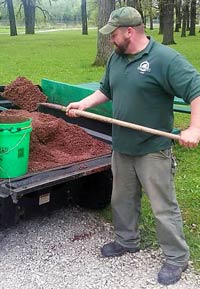 PDRMA’s Next Top…Model?
PDRMA’s Next Top…Model?
You won’t see them on America’s Next Top Model, but PDRMA members who do risk modeling by digging into the data in their loss reports can still be big winners. Compiling and analyzing the data in loss reports can lead to significant improvements in agency safety records by identifying your agency’s risk trends and developing a plan to minimize them.
For instance, at the Forest Preserve District of Kane County, Chuck Misner, Safety, Health and Training Coordinator, reviewed eight years of loss reports and individual incident reports, sorted by year, month, activity and work group. It was an enlightening process.
“We had a rather flat employee injury rate over the past eight years, averaging 13 injuries per year,” Misner reports. “Based on the frequency and severity of injuries over that time, our Safety Team decided that back injuries should be our primary focus.”
PDRMA’s Injury Prevention Program (PIPP) was a major asset in the process. “Our biggest challenge was deciding where to start,” he explains. “There are so many ways to address injuries. We used PIPP to identify the risk and put some structure to it, and our Safety Team focused on individual training and communication. We used PDRMA videos and training, as well.”
 Staff outreach kept everyone focused with monthly email updates, flyers for departmental safety briefings and periodic staff meetings. Misner developed a department-specific training module and taught back safety to field operations staff. He credits a field visit and follow up by Dr. Jim Clapper, Ergonomics Specialist, along with an annual Safety Rodeo with helping the program be successful. “We have individual training stations for employees to learn from each other, and we use different pieces of equipment each time. I also conduct personal injury-prevention coaching sessions with each employee after an injury occurs. These sessions were key in preventing repeat injuries by being able to determine the root cause. It really takes hands-on effort by everyone to make it work.” Staff outreach kept everyone focused with monthly email updates, flyers for departmental safety briefings and periodic staff meetings. Misner developed a department-specific training module and taught back safety to field operations staff. He credits a field visit and follow up by Dr. Jim Clapper, Ergonomics Specialist, along with an annual Safety Rodeo with helping the program be successful. “We have individual training stations for employees to learn from each other, and we use different pieces of equipment each time. I also conduct personal injury-prevention coaching sessions with each employee after an injury occurs. These sessions were key in preventing repeat injuries by being able to determine the root cause. It really takes hands-on effort by everyone to make it work.”
The result? “We finished 2016 with only six injuries — a 54-percent reduction,” Misner reports. He advises fellow members that people are the key to success. “They are the key to pulling everything together. If your employees take ownership, the process will work. It takes a lot of face-to-face and hands-on communication to build a world-class safety culture.”
At Decatur Park District, metrics, monitoring, transparency and targeted actions were decisive in its dramatic turnaround story, according to Kristi Orrick, Manager of Human Resources and Risk Management.
“We’re being more transparent with staff about our losses,” Orrick explains. The Safety Committee reviews the statistics at the beginning of the year, checks them at the mid-way point and re-evaluates everything at year-end to see if there is improvement. “We look for patterns in frequency, severity, types of losses — and if any department is having more losses than others.”
Their diligent focus on metrics is paying off. For the past three years, the agency reduced its slip/trip/fall and material handling losses. “We implemented a footwear policy — especially ice cleats — and enforced stretching and ergonomics through multiple trainings,” Orrick notes. “Visits by Dr. Jim Clapper and from our local Corporate Health Facility helped staff learn proper lifting, stretching and ergonomics.”
However, two areas remain problematic. “Vehicle accidents have been consistently high for the last three years,” she observes. “Even though most of those accidents were not the agency’s fault, we will begin requiring all staff that drives park district vehicles to complete a mandatory defensive driving training this year.” And as for many members, training seasonal employees remains a challenge. “We adjust the training schedule to get to each department when seasonal staff comes on board each year, and we look for ways for our Safety Committee to get information to seasonal employees at staff meetings, morning huddles or during on-the-job training.”
Even with those challenges, the agency has managed a stunning turnaround in one major category. Slip/trip/fall claims have plummeted after several large-scale, ice-related claims three years ago. “Our claim costs dropped from $182,567 in 2014 to $692 in 2015 — and just $122 in 2016,” Orrick notes. “We remind everyone that our goal is to have all employees return home safely every day, so our goal is $0 — but we’re very pleased with the improvements we are making.”
Orrick credits PDRMA for help in reducing Decatur’s losses, too. “PDRMA helped us develop a Central Illinois Safety Group,” she explains. “It allows us to network, share safety ideas and collaborate to plan downstate trainings. Our managers and staff can now go to safety trainings they wouldn’t have been able to attend. And PDRMA's online training resources help, too.”
In the end, Orrick says, the answers are in the numbers. “Metrics will really help you analyze where you need to focus your energy and resources. Each agency’s losses and challenges are different, but if you break them down, you can figure out where to start or what to target for your training and whether you’re making improvements.” |

